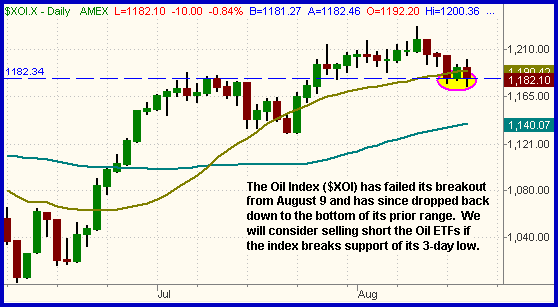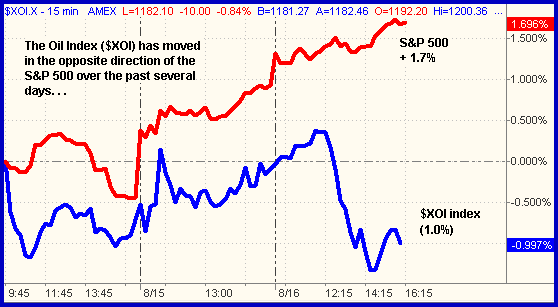This sector is displaying a failed breakout
For the second consecutive day, the
major indices gapped higher on the open, trended upwards throughout
the session, then finished near their intraday highs. The Nasdaq Composite
(
COMP |
Quote |
Chart |
News |
PowerRating)
rallied 1.6%, the S&P 500 0.8%, and the Dow Jones Industrial Average 0.9%. Both
the small-cap Russell 2000 and S&P Midcap 400 indices gained 1.4%. Because the
S&P closed at a new three-month high, our position in the UltraShort S&P 500
ProShares
(
SDS |
Quote |
Chart |
News |
PowerRating) was stopped out, but our long position in the Pharmaceutical
HOLDR
(
PPH |
Quote |
Chart |
News |
PowerRating) moved further into positive territory. The iShares Russell 2000
(
IWM |
Quote |
Chart |
News |
PowerRating) closed just below our stop, which is based on resistance of its
200-day moving average.
Higher turnover again confirmed yesterday’s positive price
action, as institutions have begun creeping back into the market. Total volume
in the Nasdaq surged 22% higher, but volume in the NYSE was only 6% above the
previous day’s level. Although turnover rose in both exchanges, only the
Nasdaq’s volume came in above its 50-day average level. It was the first time in
five sessions that it did so. Both the S&P and Nasdaq registered their second
straight “accumulation days” yesterday. However, the action in the Nasdaq was
more positive due to both greater price gains and a more significant
increase in volume. Market internals were solid across the board. In the NYSE,
advancing volume exceeded declining volume by a margin of 4 to 1, while the
Nasdaq ratio was positive by more than 5 to 1.
Clearly, overall market sentiment has changed over the past
two days. Stocks have begun to close near their highs, rather than selling off
into the close. The handful of stocks that have broken out to new highs are
holding well so far, and a plethora of stocks have begun to break out above
their bases of consolidation or above multi-month downtrend lines. While the
talking heads of the financial media may present a host of economic or
geopolitical reasons for the market’s recent bullish action, the most likely
cause has been the technical breakout in the Semiconductor Index
(
SOX |
Quote |
Chart |
News |
PowerRating).
In yesterday’s
Wagner Daily, we
pointed out how the $SOX had broken out and closed above its 50-day MA for the
first time in more than three months. We mentioned that bullish momentum of that
breakout would likely carry the $SOX higher in the short-term, and that is
exactly what happened. The $SOX built on Tuesday’s 3.7% gain by closing another
4.3% higher yesterday. As we have discussed numerous times in the past, the $SOX
index usually leads the broad market because the semiconductor stocks are so
heavily weighted within the Nasdaq, which tends to lead the other major indices.
Given that the $SOX has rocketed 8% higher over the past two days, it’s not
surprising that the major indices have also performed well. Because we wanted
confirmation that Tuesday’s breakout in the $SOX was not a fluke, we did not yet
buy any of the semiconductor ETFs. However, now that the $SOX has confirmed its
strength by rallying sharply and closing at its intraday high on day two of the
breakout, we will be stalking both the iShares Semiconductor
(
IGW |
Quote |
Chart |
News |
PowerRating) and
Semiconductor HOLDR
(
SMH |
Quote |
Chart |
News |
PowerRating) for potential long entry. Ideally, we would like
to see a 38.2% to 50%
Fibonacci retracement of the $SOX’s two-day range, but a sideways correction
by time would also provide for a low-risk entry from here.
While the semis and other tech sectors have been moving
higher, a few sectors have been showing relative weakness to the broad market.
The Oil Sector
(
XOI |
Quote |
Chart |
News |
PowerRating), which has been in a long-term uptrend since the
beginning of 2003, is in the process of failing last week’s breakout to a fresh
all-time high and has demonstrated relative weakness over the past two days.
From July 27 to August 8, the $XOI index consolidated at its high, but in a
choppy, indecisive manner. On August 9, the index broke out above its range on
an intraday basis, but closed near the top of its prior range. Three days later,
it had fallen to the low of that range. The S&P 500 has gained a total of 2%
over the past two days, but the $XOI has ignored the strength and has actually
moved fractionally lower during that same period. If an index is showing such
relative weakness that it can only move sideways to lower while the broad market
is rallying sharply, what do you think happens when the market eventually
corrects? That index is the first one to fall and its loss will typically double
that of the broad market. The first chart of the $XOI index below illustrates
the failed breakout, while the chart below that compares the price percentage
changes of the S&P 500 and the $XOI over the past several days:


Our
ETF Roundup guide
shows there are twelve different ETFs that comprise the Energy sector. Of these,
the S&P Select Energy SPDR (XLE) has one of the better looking chart patterns
for a potential short sale if the $XOI index breaks down below support of its
three-day low. Note that the popular Oil Service HOLDR (OIH) has a very
different chart pattern than the $XOI index because it tracks companies engaged
in various oil services as opposed to Oil Production and Exploration.
Recall that we also brought your attention to the iShares DJ
Real Estate Index (IYR) a few days ago due to its failed breakout that occurred
the previous week. IYR gapped up with the major indices on Tuesday, but again
showed relative weakness yesterday by ignoring the stock market’s gains. We feel
that IYR is in the process of setting a “lower high” on its daily chart, so it
remains on our watchlist for a potential short sale. Confirmation of a “lower
high” may come when IYR rolls over below yesterday’s low, especially if that
happens while the stock market holds up.
Open ETF positions:
Long PPH, short IWM (regular subscribers to
The Wagner Daily
receive detailed stop and target prices on open positions and detailed setup
information on new ETF trade entry prices. Intraday e-mail alerts are also sent
as needed.)
Deron Wagner is the head trader of Morpheus Capital Hedge Fund and founder of
Morpheus Trading Group (morpheustrading.com),
which he launched in 2001. Wagner appears on his best-selling video, Sector
Trading Strategies (Marketplace Books, June 2002), and is co-author of both The
Long-Term Day Trader (Career Press, April 2000) and The After-Hours Trader
(McGraw Hill, August 2000). Past television appearances include CNBC, ABC, and
Yahoo! FinanceVision. He is also a frequent guest speaker at various trading and
financial conferences around the world. For a free trial to the full version of
The Wagner Daily or to learn about Deron’s other services, visit
morpheustrading.com or send an e-mail to
deron@morpheustrading.com .
Â
